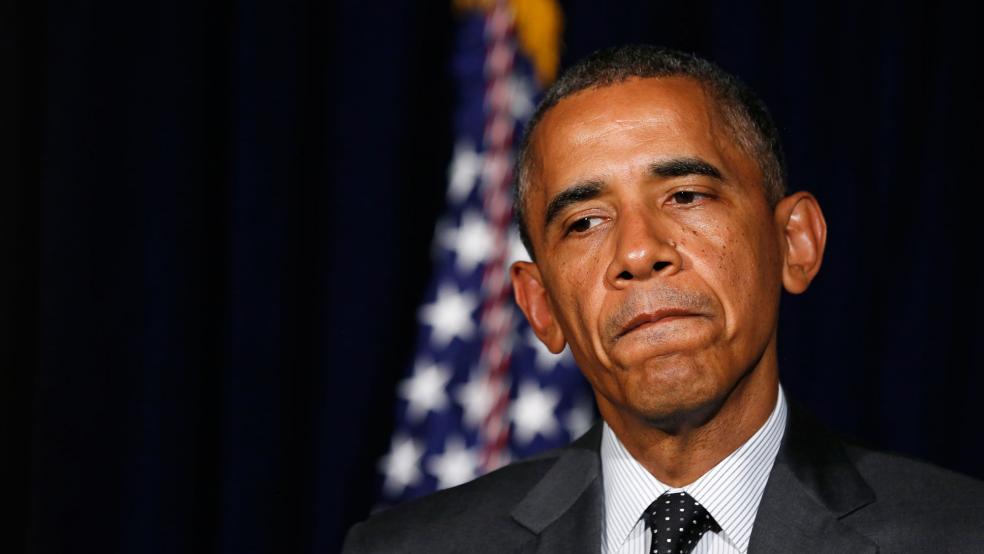Congress resolved the short-term funding crisis in the Highway Trust fund last week, approving $10.8 billion in fresh spending – but declined to set a timetable for drafting a multi-year blueprint for maintaining and expanding the nation’s infrastructure.
President Obama’s response has been to mount an ambitious “Build America” public-private partnership. It’s aimed at spurring billions of dollars’ worth of job-generating projects using innovative approaches that don’t require congressional input.
Related: Fix Infrastructure Now, or Apologize for It Forever
Just as he’s tried to use executive power to sidestep Congress on immigration, air pollution and other key issues, Obama last month signed an executive memorandum to rally state and local governments, the business community and investors on a range of infrastructure construction.
“While the president is encouraged that Congress is . . . taking action in the short-term to prevent transportation projects across the country from grinding to a halt, the president will continue to act on his own to promote American economic growth where there is need or opportunity,” the White House said in a statement.
The memorandum signed by Obama on July 17 orders initiatives that include:
- Creation of a Build America Transportation Investment Center at the Department of Transportation. It will provide “one-stop shopping” for state and local governments, public and private developers and investors who seek innovative financing strategies. The center will encourage using existing resources that provide flexible financing for highway and mass transit projects.
Related: Spending on Infrastructure Now Generates Long-Term Jobs Later
- Formation of an interagency working group “to expand and increase private investment and collaboration in infrastructure.” It will encourage private investment and partnership in municipal water purification, harbor and port development, construction of electrical grids and more.
- Scheduling a Sept. 9 Treasury Department “investment summit” of project developers, institutional investors and federal, state and local officials to create strategies for future construction.
Robert Puentes, an expert on infrastructure policy at the Brookings Institution, says many states “recognize there’s no cavalry coming” in terms of federal government aid, and that they are “going out and crafting their own solutions,” including teaming up with the private sector and seeking voter approval of new funding.
“We need to change the way we think about infrastructure in America,” Puentes said during a Brookings podcast in June. “It’s not just about the federal government fixing roads and bridges.”
Related: Ten States with the Worst Highway Spending Woes
The government spends more than $50 billion a year on surface transportation programs, mostly in grants to state and local governments; but that’s just a fraction of overall spending by governments and the private sector, according to Puentes. Many transportation, telecommunications, energy and aviation projects are undertaken without assistance from Uncle Sam.
Obama and many state officials have warned of economic risks to the U.S. unless Congress and state legislatures take action. As China and other nations struggle to enhance their competitive edge by investing heavily in roads, bridges, airports, and other infrastructure, the U.S. has begun to seriously lag.
“We need the construction jobs that come with repairs and maintenance of everything from roads and bridges to ports and airports,” said former Pennsylvania governor Ed Rendell, a co-chair of Building America’s Future, an advocacy group for construction. “But the country also desperately needs improved infrastructure so our companies can compete in a global economy.”
Mindful of the backlog in infrastructure, Obama and members of Congress began pushing for creation of a National Infrastructure Reinvestment Bank in 2007 – one that would use federal loans to leverage hundreds of billions of dollars of private investment in highways and mass transit. The idea prompted plenty of discussion but never went anywhere.
Related: Infrastructure Alert: A New Spending Plan
The last surge in infrastructure spending came after Obama’s 2009 economic stimulus program was passed. That controversial package provided $48 billion for federal transportation projects and a special grant program for critical projects that were difficult to fund. In all, the initiative sparked 15,000 transportation projects nationwide and increased employment by more than 2.3 million in 2010 alone, according to a government study.
While unveiling the Build America initiatives last month, the administration noted some states and localities already have “successful track records of public-private sector transportation projects.
One project hailed by the White House is the Denver, Colorado, FasTracks. The $6.5 billion partnership to build two new commuter rail lines in the Denver region that was approved by voters in 2004 is being financed partly by a 0.4 percent boost in the sales tax. The project combined Department of Transportation financing mechanisms with state and local government resources and private investment.
Related: Obama’s Stimulus Plan: What Worked, What Didn’t
The first major line of the 122 miles of new light and commuter rail opened last year, with construction continuing on the rest. The administration called the project a “transformative, multi-modal public infrastructure project.”
But it also has many critics, including Randal O’Toole, a senior fellow with the libertarian Cato Institute, who called it a “boondoggle.”
“The FasTracks public-private partnership projects are, in my opinion, a scam,” O’Toole told The Fiscal Times on Tuesday. “They are not in any way designed to save the public money. Instead, they are aimed at circumventing legal debt limits.”
The project’s original cost had been pegged at $4.7 billion but was increased to $6.5 billion or more, according to varying estimates. To complete the project despite the higher cost meant taking on more debt, said O’Toole. “The Obama administration considers this a positive example of ‘creative financing,’” he said. “I consider it a way of lying to voters: First they lied about the real cost of the project, then they lied about how much debt taxpayers will have to repay.”
Top Reads From The Fiscal Times:





